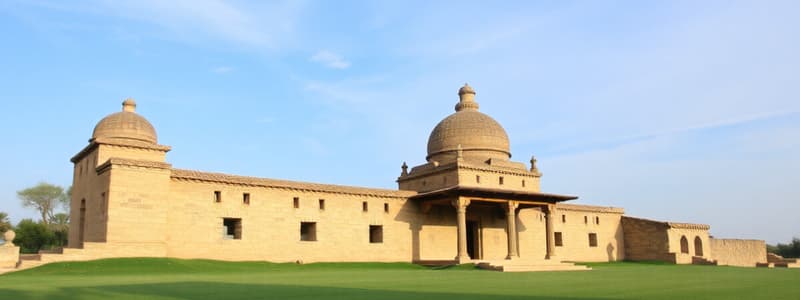Podcast
Questions and Answers
What is the record of man's effort to build beautifully?
What is the record of man's effort to build beautifully?
History of architecture
Which of the following is not one of the six influences of architecture?
Which of the following is not one of the six influences of architecture?
- Biological (correct)
- Geographical
- Climatic
- Religious
What period refers to time before written records?
What period refers to time before written records?
Prehistoric
During prehistoric times, there was no organized religion.
During prehistoric times, there was no organized religion.
What materials were used in the architectural character during prehistoric times?
What materials were used in the architectural character during prehistoric times?
What significant change occurred around 9000 BC?
What significant change occurred around 9000 BC?
The ______ era included the period marked by nomadic hunters.
The ______ era included the period marked by nomadic hunters.
Match the following early structures with their descriptions:
Match the following early structures with their descriptions:
What is a Dolmen?
What is a Dolmen?
What does the history of architecture represent?
What does the history of architecture represent?
Which of the following is NOT one of the six influences of architecture?
Which of the following is NOT one of the six influences of architecture?
What characterizes the Prehistoric period in architecture?
What characterizes the Prehistoric period in architecture?
Humans settled far north due to the cold climate.
Humans settled far north due to the cold climate.
What materials were used in prehistoric architectural character?
What materials were used in prehistoric architectural character?
Match the following Stone Age periods with their characteristics:
Match the following Stone Age periods with their characteristics:
Name an example of an early human settlement structure.
Name an example of an early human settlement structure.
Which structure is associated with the Navaho Indian dwelling?
Which structure is associated with the Navaho Indian dwelling?
The ______ is an example of an Eskimo house.
The ______ is an example of an Eskimo house.
What was primarily practiced by people by 9000 BC?
What was primarily practiced by people by 9000 BC?
Flashcards are hidden until you start studying
Study Notes
History of Architecture
- Reflects humanity's aspiration to create beauty through structures.
- Documents the evolution of architectural styles across different cultures and eras.
Influences on Architecture
- Key factors shaping architecture include:
- Geographical
- Geological
- Climatic
- Religious
- Social
- Historical
Prehistoric Architecture
- Represents the period before written records.
- Relies on artifacts for understanding, presenting a challenge to interpret non-verbal clues.
Religious Influences
- Absence of organized religion characterized early societies.
- Respect for the deceased shown through burial practices and monuments.
Architectural Characteristics
- Utilized materials include animal skins, wood, and bones.
- Structures often consisted of natural or excavated caves.
- Decorated with cave paintings found in regions such as Africa, France, and Spain.
Historical Context
- Early human evolution traced back 2.3 million years in Africa with species such as Homo habilis and Homo sapiens.
- Tool development was crucial to the survival and adaptability of early humans.
Migration Patterns
- Early humans migrated from Africa to Southern Europe and Asia, limited by climate.
- Spreading to North America from Siberia and to Australia by boat.
Settlements and Agriculture
- Transition from nomadic lifestyles (pre-9000 BC) to settled agriculture facilitated by fertile land and food sources.
- Development of villages in regions like the Middle East, South America, and China.
Stone Ages
- Paleolithic (Old Stone Age): nomadic hunter-gatherer lifestyle.
- Mesolithic (Middle Stone Age): transitional phase toward settled living.
- Neolithic (New Stone Age): permanent settlements established.
Bronze and Iron Ages
- Bronze Age included the Minoan Period and early Greek architecture.
- Iron Age occurred approximately 25 to 50 years prior to Julius Caesar.
Early Structures
- Rock caves functioned as the earliest human habitation, categorized as natural or artificial.
- Diverse dwelling types emerged:
- Hogan: traditional Navajo dwelling.
- Tipi: portable shelter used by various Native American tribes.
- Beehive Hut: structure in Ireland made with earth and logs.
- Igloo: ice house constructed by Eskimos.
- Wigwam: American Indian dwelling, often made from bark and rush mats.
- Trullo: unique conical-roofed buildings in Southern Italy.
Research Assignment
- Suggested research topics include:
- Megaliths
- Menhirs
- Dolmens
- Cromlechs
- Tumuli
Pre-Historic Architecture Project
- Instructions to create visual representations of Dolmen and Stonehenge with accompanying descriptions.
History of Architecture
- Reflects humanity's aspiration to create beauty through structures.
- Documents the evolution of architectural styles across different cultures and eras.
Influences on Architecture
- Key factors shaping architecture include:
- Geographical
- Geological
- Climatic
- Religious
- Social
- Historical
Prehistoric Architecture
- Represents the period before written records.
- Relies on artifacts for understanding, presenting a challenge to interpret non-verbal clues.
Religious Influences
- Absence of organized religion characterized early societies.
- Respect for the deceased shown through burial practices and monuments.
Architectural Characteristics
- Utilized materials include animal skins, wood, and bones.
- Structures often consisted of natural or excavated caves.
- Decorated with cave paintings found in regions such as Africa, France, and Spain.
Historical Context
- Early human evolution traced back 2.3 million years in Africa with species such as Homo habilis and Homo sapiens.
- Tool development was crucial to the survival and adaptability of early humans.
Migration Patterns
- Early humans migrated from Africa to Southern Europe and Asia, limited by climate.
- Spreading to North America from Siberia and to Australia by boat.
Settlements and Agriculture
- Transition from nomadic lifestyles (pre-9000 BC) to settled agriculture facilitated by fertile land and food sources.
- Development of villages in regions like the Middle East, South America, and China.
Stone Ages
- Paleolithic (Old Stone Age): nomadic hunter-gatherer lifestyle.
- Mesolithic (Middle Stone Age): transitional phase toward settled living.
- Neolithic (New Stone Age): permanent settlements established.
Bronze and Iron Ages
- Bronze Age included the Minoan Period and early Greek architecture.
- Iron Age occurred approximately 25 to 50 years prior to Julius Caesar.
Early Structures
- Rock caves functioned as the earliest human habitation, categorized as natural or artificial.
- Diverse dwelling types emerged:
- Hogan: traditional Navajo dwelling.
- Tipi: portable shelter used by various Native American tribes.
- Beehive Hut: structure in Ireland made with earth and logs.
- Igloo: ice house constructed by Eskimos.
- Wigwam: American Indian dwelling, often made from bark and rush mats.
- Trullo: unique conical-roofed buildings in Southern Italy.
Research Assignment
- Suggested research topics include:
- Megaliths
- Menhirs
- Dolmens
- Cromlechs
- Tumuli
Pre-Historic Architecture Project
- Instructions to create visual representations of Dolmen and Stonehenge with accompanying descriptions.
Studying That Suits You
Use AI to generate personalized quizzes and flashcards to suit your learning preferences.




